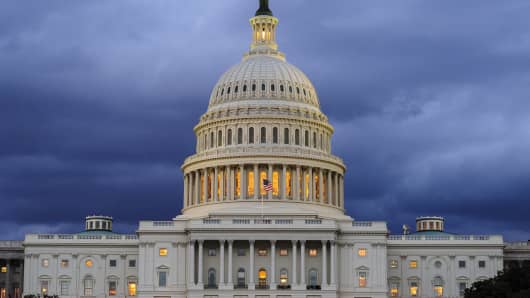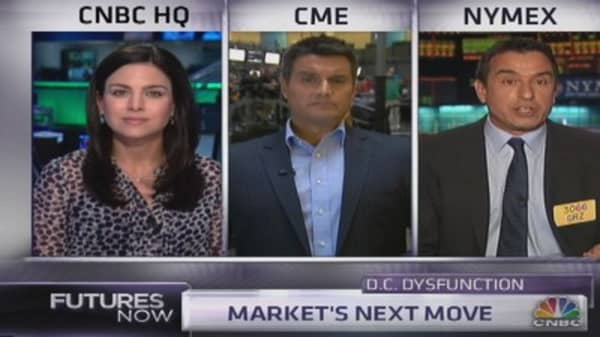Such a default could wreak much deeper havoc than the ongoing government shutdown.
Though disruptive and costly, the current budget freeze is expected to have limited impact on the economy and financial markets, which so far have largely shrugged off Washington's fiscal follies.
While hundreds of thousands of government workers have been sent home, much of the government is operating under spending rules that allow most agencies to keep functioning. That's why the last 17 such shutdowns have caused little long-term damage.
If the government exhausts its legal authority to borrow, however, the Treasury says it will be forced to shut off all cash payments.
(Read more: Obama: GOP shut down government over 'ideological crusade')
That's why last week's political stalemate over the federal budget—embarrassing, pointless, infuriating, to be sure—is a shaping up as mild annoyance compared to the potential mayhem looming if Congress forces the Treasury to default on its payments.
Until Monday, many observers expected Congress and the White House to reach some sort of compromise before the budget deadline. Now, many are reconsidering the outlook for averting a debt ceiling debacle.
"The shutdown doesn't bode well for the debt ceiling negotiation," said Paul Ashworth, chief U.S. economist at Capital Economics. "While the House Republican leadership is sort of willing to go along and have this partial shutdown, a debt ceiling standoff is much more dangerous. "
The nation's borrowing limit currently stands at about $16.7 trillion. Unlike virtually every other country in the developed worked—that cap has to be extended periodically by a special act of Congress. Though often contentious, the once-routine debt ceiling extension has recently become a political weapon of mass destruction.
Congress came close to forcing a Treasury default in July 2011, pulling back from the brink at the last minute and agreeing to a compromise. The spectacle cost the U.S. its Triple-A credit rating, but no payments were missed. Now, with Congress still dug in over a bitter fight to delay the White House's health care reform law, there's little time left to avert a freeze on government borrowing.
Unlike the hard deadline of the new fiscal year that began Tuesday, the debt ceiling deadline is more complex and dangerous because it's not clear just when it will be reached. The Treasury has been deferring some payments and tapping reserves, but last week estimated that it will exhaust those "extraordinary measures" in less than three weeks.
The forecast is complicated by the complexities of government spending and receipts, which don't flow in a steady stream week-in, week-out like a household paying regular monthly bills with a fixed weekly paycheck.
(Read more: 800,000 out of work as US government shuts down)
With some 80 million payments moving through the system each month, the government's revenues and expenses ebb and flow with irregular, sometimes unpredictable, peaks and troughs on both the income and payment sides of the ledger. Social Security checks typically go out at the beginning of the month, for example. Quarterly tax receipts, on the other hand, typically cluster around the middle of the month.






